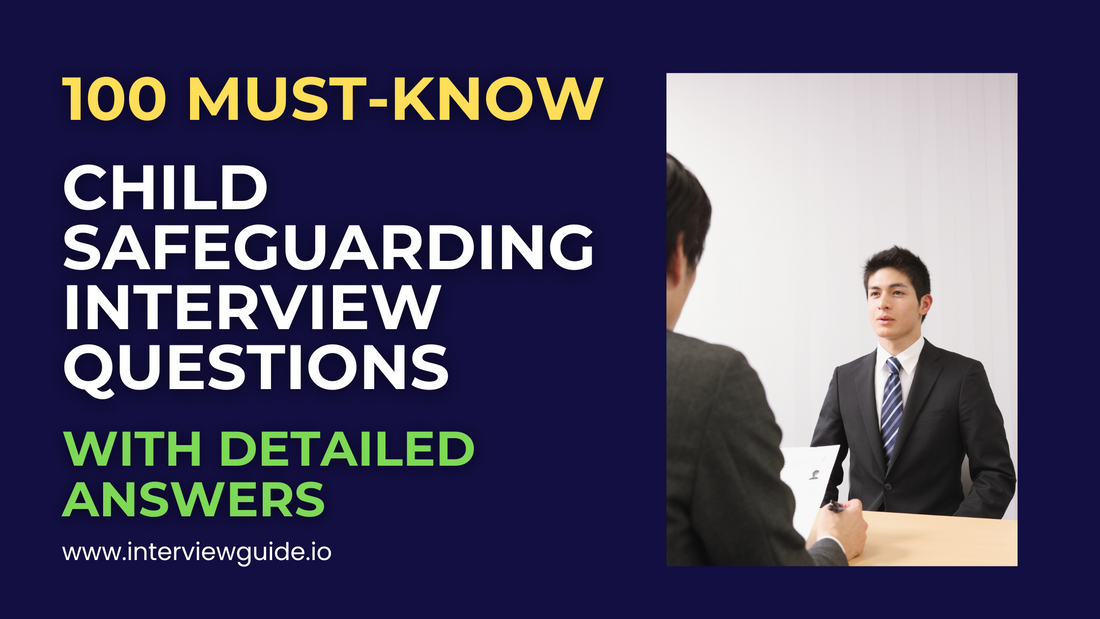
100 Child Safeguarding Interview Questions & Answers
Share
Preparing for a Child Safeguarding job interview? Whether you’re applying for a role in education, social services, healthcare, or a nonprofit organization, it’s essential to understand the key principles and responsibilities involved in protecting children from harm. Employers are looking for candidates who are not only knowledgeable about safeguarding policies and legal requirements but also compassionate, observant, and capable of acting decisively in sensitive situations.
In this article, we’ve compiled 100 of the most common Child Safeguarding interview questions, along with sample answers to help you prepare effectively. From recognizing signs of abuse and managing disclosures to working with multi-agency teams and maintaining accurate records, this guide will help you approach your interview with confidence and demonstrate your commitment to keeping children safe. Let’s get started!
1. What Does Child Safeguarding Mean To You?
Child safeguarding means creating an environment where children feel safe, respected, and protected from harm. It involves proactive measures to prevent abuse and neglect, ensuring that their well-being is prioritized in all settings. This encompasses recognizing potential risks, understanding the signs of abuse, and having clear procedures in place for reporting concerns. Safeguarding is about building trusting relationships with children, empowering them to speak up, and ensuring their voices are heard. It also involves collaboration with families, communities, and professionals to create a holistic approach that supports the child's physical, emotional, and psychological development.
2. How Does Safeguarding Differ From Child Protection?
Safeguarding refers to the broader framework designed to promote the welfare of children and protect them from harm. It encompasses preventative measures, creating safe environments, and fostering healthy relationships to ensure children's rights are upheld. Child protection, however, is more specific, focusing on responding to and addressing actual incidents of abuse or neglect. While safeguarding aims to prevent harm through proactive strategies, child protection involves intervention and response to reported concerns. Both concepts are interconnected, but safeguarding is the proactive approach, while child protection is reactive, dealing with specific cases of abuse.
3. Why Is Safeguarding Important In Your Role?
Safeguarding is crucial in my role as it ensures the safety, well-being, and protection of children. It creates an environment where children can thrive without fear of abuse or neglect. By prioritizing safeguarding, I foster trust and open communication, encouraging children to share their concerns. This proactive approach enables early identification of potential issues, allowing for timely interventions. Understanding safeguarding principles helps me navigate complex situations, ensuring I act in the best interests of the child. Ultimately, safeguarding is about empowering children, supporting their rights, and promoting their development in a safe and nurturing environment.
4. What Are The Key Principles Of Safeguarding Children?
The key principles of safeguarding children include the paramountcy of the child's welfare, ensuring that their best interests are the primary consideration in all actions and decisions. It emphasizes the importance of listening to children and valuing their views, promoting their rights and ensuring they are treated with respect. Additionally, there is a focus on prevention, aiming to act proactively to avoid harm rather than just responding reactively. Multi-agency collaboration is crucial, fostering communication and cooperation between various professionals involved in child welfare. Lastly, ensuring transparency and accountability in safeguarding practices enhances trust and effectiveness in protecting children.
5. Can You List The Main Types Of Abuse?
The main types of abuse include physical abuse, emotional abuse, sexual abuse, and neglect.
Physical abuse involves causing physical harm to a child through actions like hitting or shaking. Emotional abuse pertains to behaviors that harm a child's emotional development, including constant criticism or rejection. Sexual abuse encompasses any sexual activity with a child, including exploitation or coercion. Neglect refers to the failure to meet a child's basic needs, such as food, shelter, education, or medical care. Recognizing these types is crucial for identifying at-risk children and ensuring they receive the protection and support they need. Being vigilant and informed can help professionals intervene effectively.
6. What Is The Difference Between Abuse And Neglect?
Abuse involves intentional harm or mistreatment of a child, which can manifest in various forms such as physical, emotional, or sexual abuse. It is characterized by actions that cause pain, suffering, or significant distress to the child. Neglect, on the other hand, refers to the failure to provide for a child's basic needs, including physical, emotional, educational, and medical care. While abuse is often a deliberate act, neglect may stem from a lack of awareness, resources, or capability. Both abuse and neglect can severely impact a child's development and well-being, making it essential to recognize and address each issue appropriately.
7. Who Is Responsible For Safeguarding Children?
The responsibility for safeguarding children is shared among various individuals and organizations. Parents and caregivers play a primary role in ensuring the safety and well-being of their children. In professional settings, educators, healthcare workers, social workers, and other child-focused professionals are mandated to act in the best interest of children. Local authorities and government bodies set the legal framework and guidelines for safeguarding practices. Everyone in the community, including neighbors and family members, should be vigilant and report any concerns. A collaborative approach ensures that safeguarding measures are effective and responsive to children's needs.
8. What Legislation Governs Child Safeguarding In This Country?
In the UK, child safeguarding is primarily governed by the Children Act 1989 and 2004, which establish the legal framework for protecting children and promoting their welfare. The Working Together to Safeguard Children guidance outlines how various agencies should work together to safeguard children. Keeping Children Safe in Education (KCSIE) focuses on safeguarding within educational settings, emphasizing the responsibilities of schools and colleges in protecting children. Additionally, the Safeguarding Vulnerable Groups Act 2006 regulates background checks for those working with children, ensuring that individuals are suitable for such roles. These pieces of legislation collectively aim to create a safe environment for children.
9. What Are The Signs Of Emotional Abuse In Children?
Emotional abuse in children can manifest through various signs that may be subtle or more overt. Common indicators include excessive fearfulness, low self-esteem, or withdrawal from social interactions. Children may exhibit anxiety, depression, or changes in behavior such as aggression or regression to earlier developmental stages. They might also show signs of attachment issues, such as being overly clingy or showing reluctance to engage with caregivers. Additionally, a child may have difficulty trusting others, display dramatic mood swings, or experience academic decline. Recognizing these signs is crucial for timely intervention and support.
10. How Might A Child’s Behavior Indicate They’re Being Abused?
A child’s behavior can reveal signs of possible abuse. For instance, sudden changes in behavior, such as increased aggression, withdrawal, or anxiety, may indicate distress. Children might exhibit excessive fear of certain adults or environments, displaying signs of panic when faced with specific situations. They may also regress to behaviors typical of a younger age, such as bedwetting or thumb-sucking. In some cases, a child may become unusually compliant or clingy, seeking constant reassurance and attention. Additionally, changes in academic performance or social interactions can further suggest underlying issues related to abuse, warranting careful observation and appropriate action.
11. What Is Contextual Safeguarding?
Contextual safeguarding refers to an approach that recognizes the wider social contexts in which children grow and develop. It acknowledges that a child’s environment, including their relationships with peers, family, and community, can significantly influence their safety and well-being. This framework extends beyond traditional safeguarding, focusing on the contexts of risk and harm, such as neighborhood violence, peer pressure, or online interactions. By understanding these external factors, practitioners can develop tailored interventions that address the specific challenges faced by children in different settings, ensuring a more holistic and effective safeguarding strategy.
12. What Is The Role Of Designated Safeguarding Lead (DSL)?
The Designated Safeguarding Lead (DSL) plays a crucial role in ensuring the welfare and protection of children within an organization. Responsibilities include overseeing safeguarding policies, providing guidance and support to staff on safeguarding issues, and ensuring that all concerns are reported and managed appropriately. The DSL acts as a point of contact for external agencies, leads training sessions for staff, and keeps up-to-date with legislation and best practices. They are also responsible for maintaining accurate records of safeguarding concerns and ensuring that children’s voices are heard in safeguarding matters. This role is vital for creating a safe environment for children.
13. How Often Should Safeguarding Training Be Undertaken?
Safeguarding training should be undertaken regularly, ideally at least once a year, to ensure that staff members remain informed about current policies, practices, and legal requirements. This frequency allows for updates on any changes in legislation or procedures, as well as the introduction of new safeguarding issues. Additionally, refresher courses can help reinforce knowledge and skills, keeping safeguarding at the forefront of staff responsibilities. New employees should receive training as part of their onboarding process. Continuous professional development opportunities should also be encouraged to maintain a high standard of safeguarding awareness within the organization.
14. What Does “Duty Of Care” Mean In The Context Of Safeguarding?
In the context of safeguarding, "duty of care" refers to the legal and ethical obligation of professionals to ensure the safety and well-being of children in their care. This means taking reasonable steps to prevent harm and acting in the best interests of the child. It involves recognizing potential risks, providing a safe environment, and being vigilant about signs of abuse or neglect. Professionals must also be prepared to respond appropriately if concerns arise, ensuring that children feel secure and supported. This duty extends beyond immediate safety to include promoting the emotional and physical development of children in their care.
15. How Would You Define Whistleblowing In Safeguarding?
Whistleblowing in safeguarding refers to the act of reporting concerns about wrongdoing or misconduct related to the welfare of children. This can involve disclosing information regarding suspected abuse, neglect, or breaches of safeguarding policies. Whistleblowers protect children by ensuring that their concerns reach the appropriate authorities or designated personnel. It is crucial that individuals feel safe and supported when raising these issues, as fear of retaliation can deter them from speaking out. Organizations should foster a culture of transparency and encourage reporting to safeguard children effectively.
Click here to download all 100 questions and answers as a PDF
